Digital Branding Strategies
How to Conduct a Successful UX Research Process: A Step-by-Step Guide
Overview
This article presents a comprehensive guide to conducting a successful UX research process, outlining each step from planning to execution and analysis. It asserts the critical importance of defining clear study goals and selecting appropriate research methods. Furthermore, it emphasizes the necessity of effectively communicating findings to stakeholders. By doing so, the research is positioned to yield actionable insights that significantly enhance user experience and drive superior design outcomes.
Introduction
In a world where user expectations are constantly evolving, understanding user experience (UX) has never been more critical for businesses aiming to thrive in the digital landscape. UX research serves as the backbone of effective design, providing invaluable insights into user behaviors, needs, and motivations.
By employing a systematic approach that combines both qualitative and quantitative methods, organizations can create products that not only meet functional requirements but also resonate emotionally with users. As competition intensifies, the financial stakes are high; companies that prioritize UX research are more likely to enhance customer satisfaction, loyalty, and ultimately, their bottom line.
This article delves into the significance of UX research, exploring its methodologies, best practices, and the transformative impact it can have on design strategies and business success.
Understanding UX Research: Definition and Importance
User Experience (UX) analysis stands as a structured method for comprehending target individuals and their needs, providing crucial insights that guide design procedures. This study encompasses both qualitative and quantitative data gathering, enabling designers to thoroughly understand individuals’ behaviors, needs, and motivations. The significance of the UX research process is profound; it empowers designers to create products that are not only functional but also enjoyable and intuitive to use.
In today’s competitive digital environment, delivering an exceptional experience for individuals is paramount. Statistics reveal that 80% of consumers are willing to pay more for a better user experience, underscoring the financial implications of effective UX design. Furthermore, organizations with developed inquiry practices are 1.9 times more likely to report enhanced customer satisfaction, emphasizing the importance of grasping customer needs throughout the product life cycle.
Recent studies indicate that a well-executed UX research process can lead to substantial improvements in customer loyalty and satisfaction. For instance, a well-constructed interface can enhance website conversion rates by as much as 200%, while an emphasis on experience can elevate these rates by a remarkable 400%. Additionally, personalizing push notifications can increase reaction rates by up to 400%, further highlighting the financial benefits of effective UX strategies.
Conversely, poor user experiences can result in significant losses, with an estimated $2.6 billion lost annually due to slow-loading websites. Successful studies in the UX research process have demonstrated their effectiveness in improving customer satisfaction. For example, brands that prioritize the UX research process often see measurable outcomes, such as increased engagement and loyalty. As industry specialists highlight, “In a world where consumer expectations change swiftly, a data-driven strategy is the beacon that directs businesses toward sustainable success.”
By prioritizing client needs, businesses can not only enhance customer satisfaction but also achieve better market performance. The competitive edge gained through exceptional UX can serve as a crucial differentiator among brands, making it vital for businesses to invest in UX analysis.
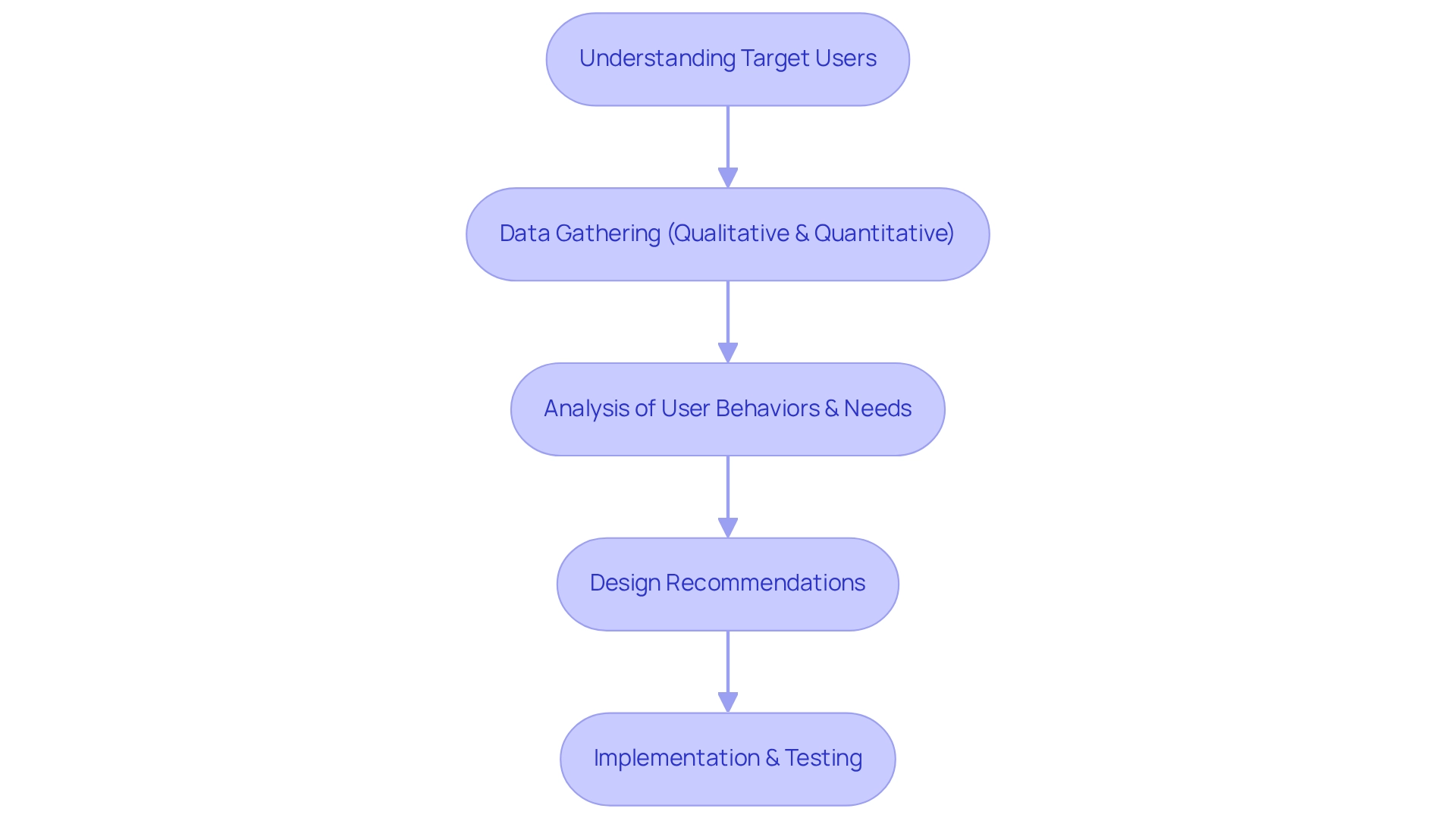
The Role of UX Research in Enhancing User Experience
UX investigation is essential for enhancing user experience, offering critical insights that inform design decisions. By pinpointing client pain points and frustrations, designers can proactively tackle these issues, resulting in more intuitive interfaces that meet client expectations. This customer-centric approach not only improves usability but also cultivates a positive emotional connection between users and the brand, ultimately driving greater engagement and retention.
Statistics underscore the significance of effective UX research:
- Personalizing push notifications can elevate reaction rates by as much as 400%.
- A well-designed interface can increase your website’s conversion rate by up to 200%, as noted by Matt Paige.
- The demand for UX designers is projected to grow by 16% from 2021 to 2031, reflecting the increasing recognition of the importance of experience in business strategies.
User frustrations are prevalent, with:
- 66% of mobile sites featuring tappable elements that are too close together.
- 32% having elements that are too small, complicating navigation.
These insights underscore the necessity for businesses to refine their UX strategies to better align with customer needs. For example, 81% of consumers express a desire for enhanced self-service options, a trend accelerated by the pandemic.
This demand highlights the importance of integrating self-service features into UX design. Organizations that leverage UX analysis to identify consumer pain points have seen significant improvements in user experience. By focusing on customer feedback, companies can create solutions that not only address functional requirements but also resonate emotionally with clients, enhancing overall satisfaction and loyalty.
The role of UX analysis in shaping user experience in 2025 and beyond cannot be overstated, as it continues to be a pivotal force behind effective design strategies.
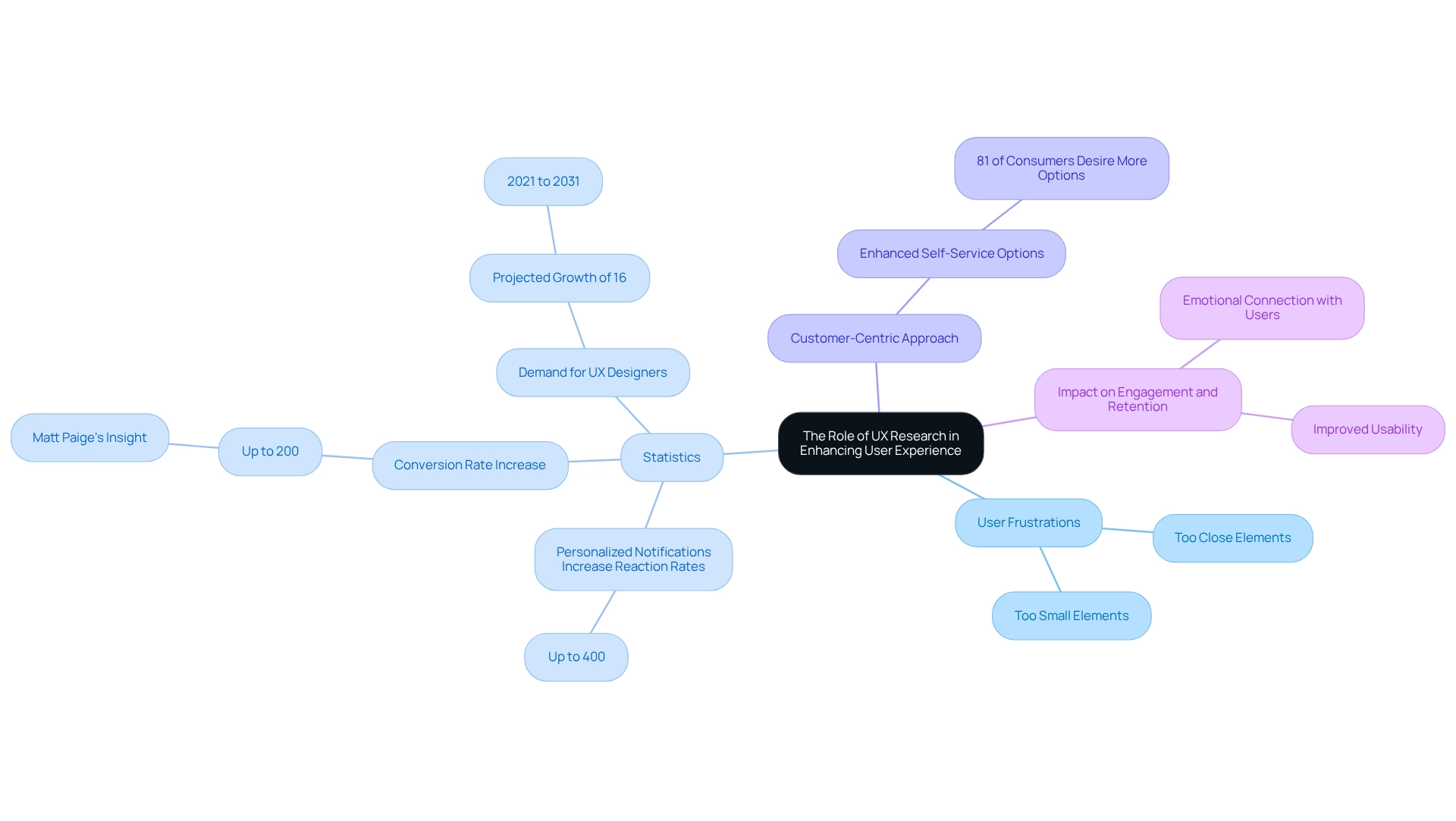
Exploring Different UX Research Methods: Qualitative and Quantitative Approaches
UX research methods can be effectively divided into qualitative and quantitative approaches, each serving distinct yet complementary purposes. Qualitative techniques, such as participant interviews, focus groups, and usability testing, delve into behaviors and motivations, providing rich, descriptive insights that illuminate the user experience. These methods are invaluable for understanding the ‘why’ behind interactions, enabling researchers to capture nuanced feedback that can inform design decisions.
Conversely, quantitative methods, including surveys and analytics, emphasize numerical data and statistical analysis. They are essential for assessing satisfaction among individuals and recognizing patterns across broader groups, addressing inquiries such as how many individuals interact with a feature or how frequently they encounter problems. Metrics like page visits, bounce rates, and conversion rates offer crucial information about user behavior, allowing teams to make data-driven choices.
Furthermore, quantitative data can encompass task completion durations and success rates from participant testing, further enriching the comprehension of interactions.
A balanced approach that integrates both qualitative and quantitative methods in the UX research process often yields the most comprehensive insights. Recent case studies demonstrate the effectiveness of this mixed-methods strategy. For instance, the case study titled “Usability Testing: Qualitative and Quantitative Approaches” illustrates how usability testing can incorporate both qualitative feedback and quantitative performance metrics, enabling researchers to tackle both the ‘what’ and the ‘why’ of interactions, resulting in more informed design enhancements.
The UX research process in 2025 underscores the importance of leveraging both types of data as part of current best practices. Utilizing power analysis can help determine the appropriate sample size for studies based on expected effect size and desired confidence levels, ensuring that findings are statistically robust. Moreover, as trends evolve, the incorporation of advanced analytics tools and feedback mechanisms is becoming progressively essential in capturing a comprehensive perspective of experiences.
As Huyen Hoang, a User Experience Researcher, states, “Since 2009 we have been helping enterprises, governmental organizations, non-profits, agencies, and startups optimize their user experience, or UX.”
In summary, employing a mixed-methods approach in the UX research process not only enhances the depth of insights obtained from UX studies but also aligns with the latest trends and best practices, ultimately leading to more effective and user-centered design solutions.
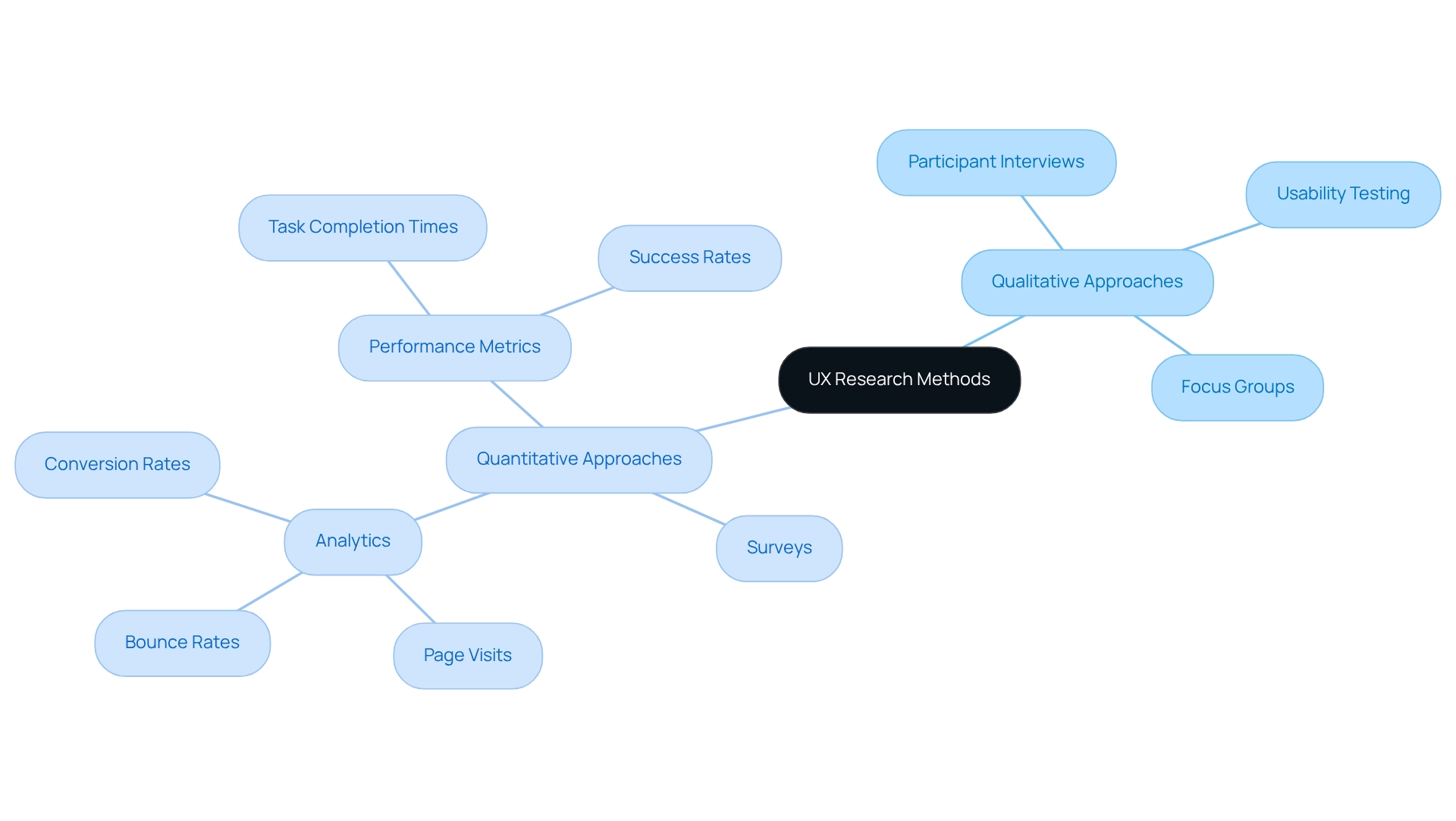
Step-by-Step Guide to Conducting UX Research: From Planning to Execution
- Define Study Goals: Articulate clear and specific objectives for your study. This involves understanding user needs, testing a prototype, or evaluating a feature’s effectiveness. Clearly defined objectives are essential, establishing the direction for your entire UX research process.
- Choose Research Methods: Select the most suitable qualitative and quantitative research methods based on your defined goals. Consider the characteristics of your target audience and the resources available to you. A balanced strategy that incorporates both types of methods can yield a comprehensive understanding.
- Recruit Participants: Identify and recruit participants who accurately represent your target user base. Aim for diversity in your participant pool to ensure a wide range of perspectives and insights. Effective recruitment strategies significantly enhance the quality of your study findings.
- Create a Study Plan: Develop a detailed study plan outlining your objectives, chosen methods, timeline, and logistical considerations. A structured plan serves as a roadmap, guiding you through the UX research process and ensuring that all essential elements are addressed.
- Conduct Investigation: Execute your study according to the established plan. While adherence to your methodology is vital, remain adaptable and receptive to adjusting your approach based on participant feedback and new insights during the UX research process.
- Examine Data: After data collection, evaluate the information to recognize patterns, findings, and areas for enhancement. This phase is crucial for transforming raw data into actionable insights that can guide decision-making.
- Report Findings: Summarize your findings in a clear and actionable format. Highlight key insights and provide recommendations for design improvements. Effective reporting ensures that stakeholders can easily comprehend the implications of your study and make informed decisions moving forward.
Integrating these steps into your UX research process not only enhances the quality of your outcomes but also aligns your efforts with the growing demand for skilled UX designers, anticipated to rise by 16% from 2021 to 2031. The significance of comprehensive UX analysis is underscored by the statistic that Citibank lost $500 million due to an employee’s oversight, illustrating the potential financial consequences of neglecting user experience. By establishing clear research objectives and employing best methods in the UX research process, you can significantly improve the success rates of your studies, ultimately leading to more effective solutions.
As Masha Panchenko, a seasoned editor and project manager, states, “Ready to experience firsthand how creativity can transform your business? Reach out to us and discover the impact of tailored design solutions on your unique goals and objectives.” Furthermore, a case study on the comprehensive campaign for Quaker Oats demonstrates how a well-planned UX research process can achieve measurable outcomes, thereby enhancing brand loyalty and sales growth.
Ultimately, a survey by UserZoom revealed that 16% of participants believe everyone on the team shares responsibility for user experience, emphasizing the collaborative aspect of UX analysis that brand managers should consider when implementing effective strategies.
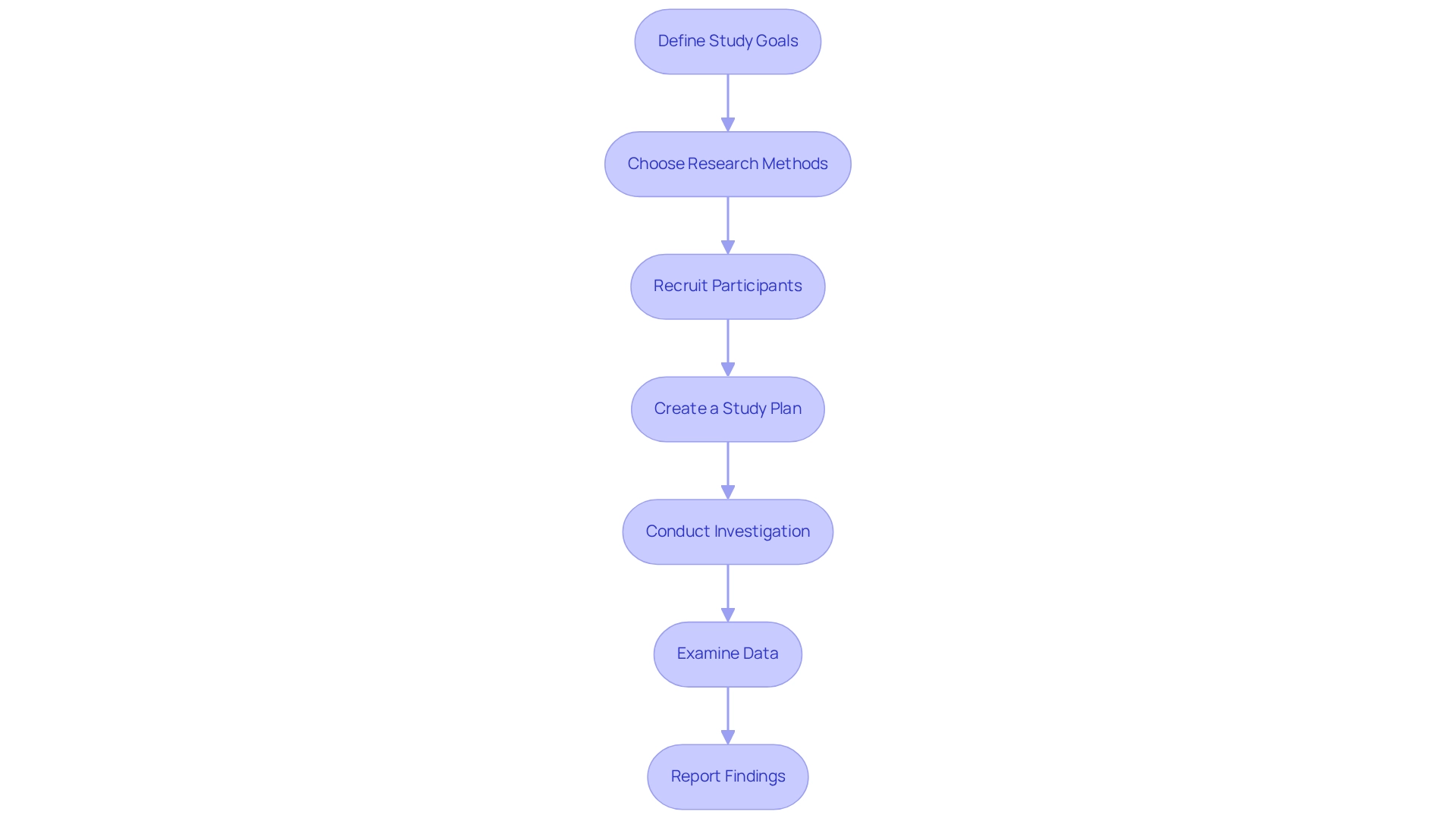
Analyzing and Synthesizing UX Research Findings for Effective Decision-Making
Analyzing and synthesizing UX research findings is a critical process that involves several essential steps:
-
Organize Data: Begin by categorizing your data into distinct themes or topics. Utilizing tools such as affinity diagrams can help visualize relationships between various observations, making it easier to identify connections and trends.
-
Identify Patterns: Look for recurring themes or patterns within the data. This step is essential as it uncovers typical behaviors and pain points, enabling a deeper comprehension of needs. Research indicates that thematic analysis can uncover significant insights, and it is advisable to allocate at least as much time for analysis as was spent on data collection to ensure thoroughness.
-
Create Customer Personas: Develop customer personas based on your findings to represent different segments of your audience. This practice is essential for cultivating empathy throughout the creation process, as it assists teams in visualizing and comprehending the varied needs and motivations of their clients. Companies that effectively create personas from UX research often observe enhanced alignment in their design strategies.
-
Prioritize Understandings: Acknowledge that not all observations hold equal significance. Prioritize findings based on their potential impact on user experience and alignment with business objectives. This prioritization guarantees that the most crucial understandings influence development choices, enhancing overall effectiveness.
-
Develop Recommendations: Convert your insights into practical suggestions for enhancements. Clearly express how these changes will improve the experience of individuals, ensuring that your team comprehends the reasoning behind each recommendation. This step is crucial for connecting the divide between investigation and practical implementation, ultimately resulting in more user-focused creation outcomes.
As Katryna Balboni, Head of Creative Content & Special Projects, observes, “Discover more about how User Interviews can assist you in completing that study within hours—whether you’re enlisting your own participants or seeking a new audience among our panel of 850k vetted individuals.” By following these steps in the UX research process, teams can effectively analyze and synthesize study findings, leading to more informed design decisions and enhanced user experiences. Furthermore, a recent case study emphasized that while UX Researchers usually concentrate on generative, exploratory investigations, Product/UX Designers are more involved in evaluative methodologies, showcasing their roles in product development and testing stages.
Moreover, it’s essential to recognize that the adoption rate for specialized UX tools is lower than that of generalist tools, which can affect the selection of resources available for brand managers in their UX initiatives.
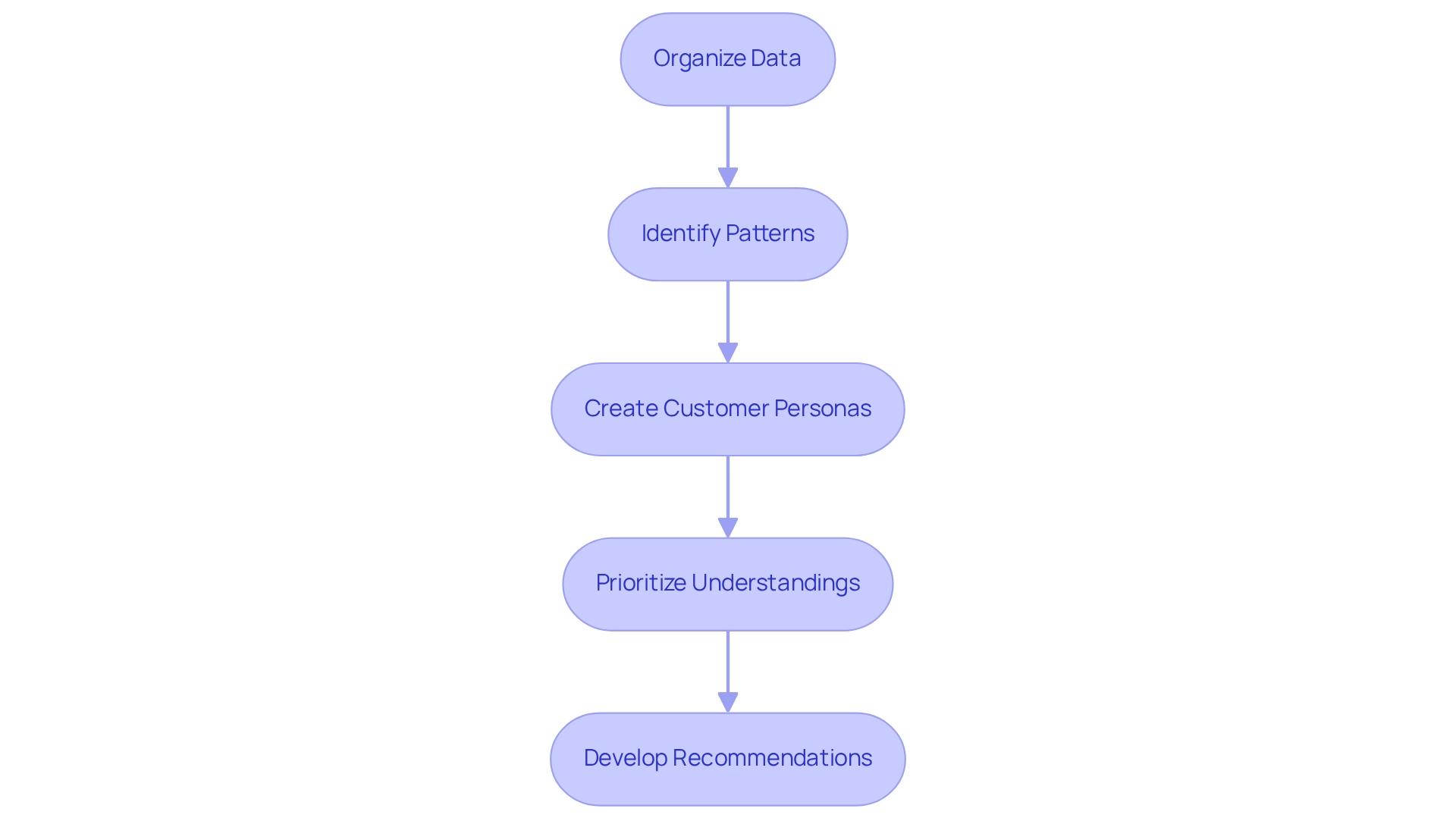
Communicating UX Research Results: Best Practices for Stakeholder Engagement
Effectively conveying UX study results is essential for influencing design choices and securing stakeholder involvement. Consider these best practices:
-
Know Your Audience: Tailor your presentation to align with the knowledge level and interests of your stakeholders. Utilize language and examples that resonate with them, ensuring that the content is relevant and accessible.
-
Be Clear and Concise: Present your findings in a straightforward manner. Avoid jargon and focus on key insights that drive decision-making. Clarity is crucial; organizations with mature research practices are 1.9 times more likely to report improved customer satisfaction, underscoring the importance of effective communication.
-
Use Visuals: Incorporate visuals such as charts, graphs, and user quotes to enhance engagement and facilitate understanding. Research indicates that effective visual aids can significantly improve the retention of information, making complex data more digestible for stakeholders.
-
Highlight Actionable Insights: Clearly outline the implications of your findings and provide specific suggestions for enhancements. This approach not only informs stakeholders but also empowers them to take actionable steps based on the research. As Annemarie Bufe, Content Manager, states, “Investing in UX development can bring many advantages to a company and is well worth the investment.”
-
Encourage Discussion: Foster an open dialogue with stakeholders to address questions and gather additional input. This collaborative method can lead to more informed choices and greater stakeholder buy-in. Engaging stakeholders in the conversation can also mitigate the 50% of developer time often spent on avoidable rework, as effective UX design defines requirements upfront.
-
Stay Updated: Acknowledge that one-fifth of scholars presently utilize AI in their studies, with numerous others intending to adopt it in the future. This modern context can guide your approach and illustrate the evolving landscape of UX study.
By adopting these best practices, you can enhance the effectiveness of your UX presentations within the research process, ensuring that your findings resonate with stakeholders and promote impactful design choices. Furthermore, organizations that prioritize understanding customer needs and integrate analysis into every phase of the product life cycle are more likely to achieve enhanced customer satisfaction, as demonstrated in the case study titled ‘Customer Satisfaction and Research Practices.

Navigating Challenges in UX Research: Tips for Success
Navigating challenges in UX research necessitates proactive strategies that command attention:
- Unclear Objectives: Establishing well-defined study goals is paramount. Employ the SMART criteria—Specific, Measurable, Achievable, Relevant, and Time-bound—to articulate clear objectives that effectively guide the UX research process. Aligning these objectives with customer needs is crucial, especially as 81% of consumers express a desire for enhanced self-service options, underscoring the significance of adaptive UX strategies.
- Participant Recruitment: Identifying the right participants can present a formidable challenge. Leverage a variety of recruitment channels, such as social media, professional networks, and community groups. Additionally, offering incentives can significantly boost participation rates, addressing the imperative of engaging diverse user groups.
- Time Constraints: Tight deadlines frequently hinder investigative initiatives. To maximize efficiency, prioritize essential inquiry questions and select techniques that yield the most beneficial findings within the available timeframe. This approach guarantees that critical data is collected without compromising quality.
- Data Overload: Analyzing extensive data sets can be overwhelming. Implement data analysis tools and techniques to streamline this process, enabling researchers to focus on the most relevant insights. This not only enhances clarity but also supports informed decision-making based on the findings.
- Stakeholder Buy-In: Gaining support from stakeholders can be a challenging endeavor. Clearly communicate the significance of UX studies by illustrating their impact on customer satisfaction and business results. Annemarie Bufe, a Content Manager, asserts, “Good UX design can enhance satisfaction and loyalty, resulting in greater customer retention and potential word-of-mouth marketing.” Involving stakeholders in the UX research process cultivates a sense of ownership and commitment, ultimately leading to more successful implementation of findings.
In 2025, addressing these challenges is more critical than ever. Successful case studies, such as the brand identity enhancement for Castania and the digital campaign for Motorola, exemplify how overcoming these obstacles can yield measurable outcomes and improved experiences. Furthermore, HubSpot’s website UX revamp, driven by user feedback, doubled and tripled conversion rates in certain areas, significantly impacting revenue.
Moreover, with one-fifth of scholars currently utilizing AI in their studies and 38% intending to do so, embracing innovative technologies can further bolster effectiveness.
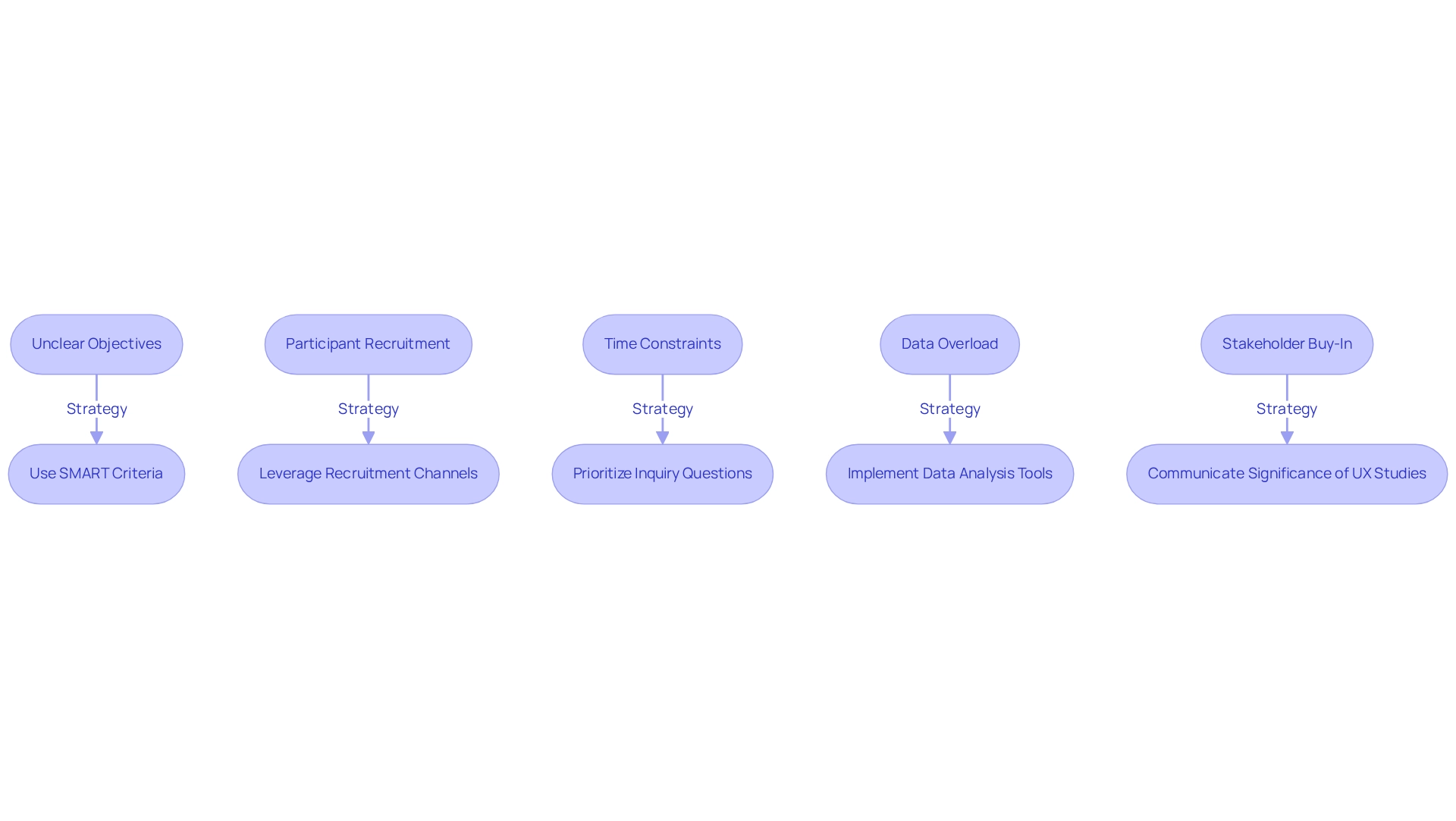
The Future of UX Research: Trends and Innovations to Watch
The future of UX research is being significantly influenced by several pivotal trends and innovations:
- Artificial Intelligence: The incorporation of AI into UX research is transforming the field by simplifying data analysis and allowing the development of tailored experiences for individuals. AI tools are particularly effective in automating repetitive tasks, managing large datasets, and enhancing reporting capabilities, which allows researchers to focus on deriving actionable insights. As Arun Yelisetti states, ‘A human interested in creating products and creations that bring joy to my users,’ emphasizes the significance of the UX research process in user-centered creation.
- Remote Investigation: The transition to remote work has accelerated the implementation of remote UX investigation techniques. This shift not only enables wider participant recruitment across various geographical areas but also allows for more flexible and adaptable frameworks within the UX research process. Innovations in remote research tools are making it simpler to conduct effective participant testing, even with individuals from diverse linguistic backgrounds, thanks to AI-powered translation tools. This capability is crucial for brand managers aiming to reach a global audience.
- Inclusive Design: There is a growing focus on inclusive design practices that prioritize the varied needs and experiences of individuals. This trend guarantees that products are reachable to everyone, promoting a more fair experience for all. By incorporating input from a diverse array of individuals in the UX research process, organizations can develop solutions that connect with a wider audience, which is crucial for brand managers aiming to strengthen brand loyalty and engagement.
- Continuous Feedback: The shift towards ongoing feedback loops from users is gaining momentum, enabling iterative design enhancements based on real-time insights. This method enables teams to stay flexible and responsive to client needs, which ultimately enhances the UX research process and improves product usability and satisfaction. For brand managers, this signifies the ability to adjust strategies rapidly based on consumer feedback gathered during the UX research process, resulting in improved market alignment.
- Mixed-Methods Approaches: The application of mixed-methods methodologies, which integrates qualitative and quantitative techniques, is becoming increasingly prevalent. This methodology in the UX research process offers a more comprehensive understanding of behaviors and preferences, enabling researchers to capture the nuances of experiences and make informed design choices. For example, a case study on scaling UX analysis with AI in large organizations demonstrates how AI facilitates efficient management of extensive datasets and global participant testing, enabling organizations to obtain deeper insights and make data-driven decisions.
As we look towards 2025, these trends will continue to shape the UX research process, driving innovations that enhance user engagement and satisfaction, ultimately benefiting brand managers in their efforts to create impactful user experiences.
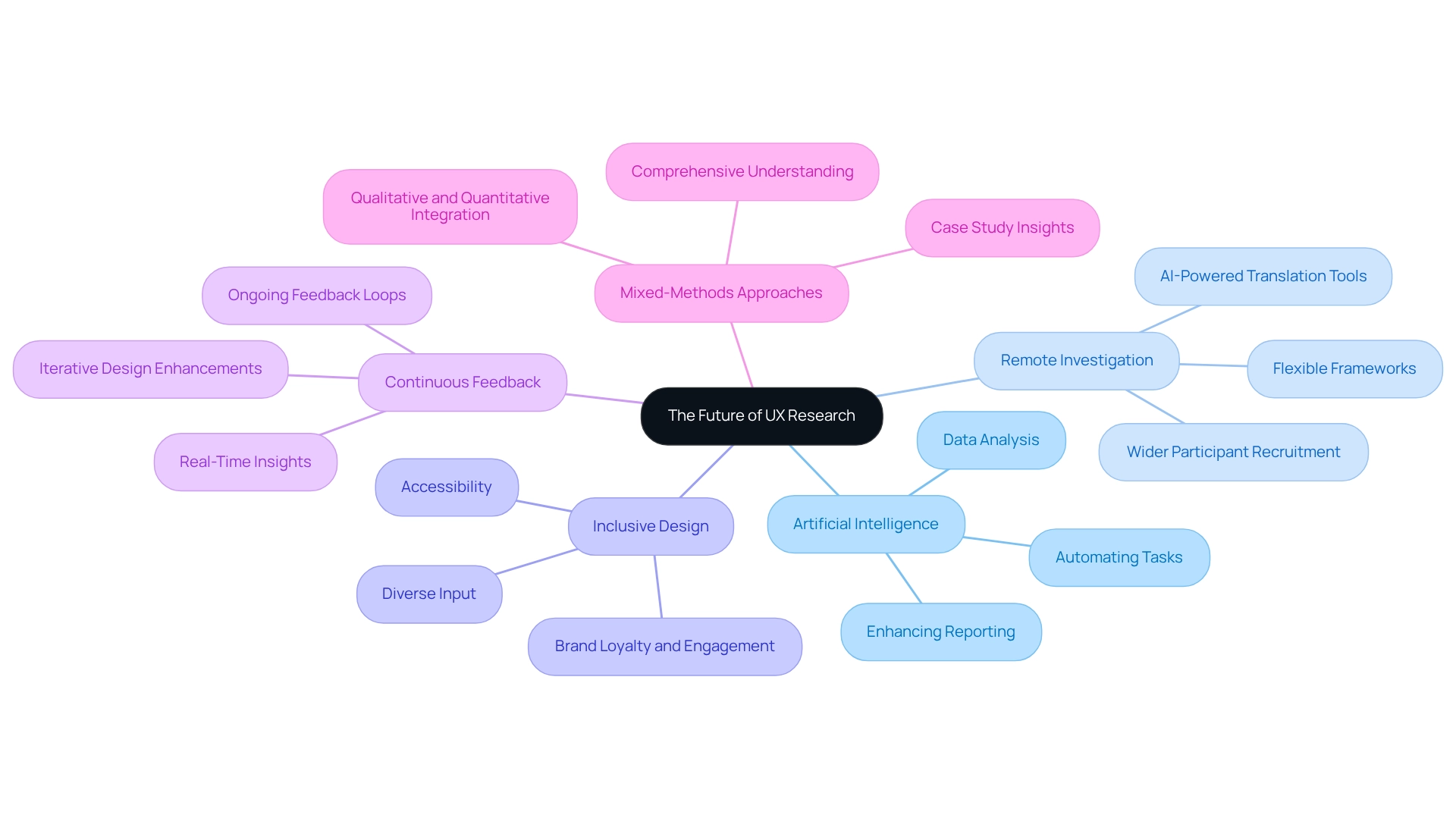
Conclusion
In an increasingly competitive digital landscape, the significance of UX research cannot be overstated. This systematic approach not only uncovers user behaviors and needs but also informs design processes that resonate emotionally with users. Companies prioritizing UX research experience significant improvements in customer satisfaction, loyalty, and conversion rates, showcasing the tangible financial benefits of investing in user experience.
The methodologies explored, including qualitative and quantitative approaches, provide a robust framework for understanding user interactions. By employing a mixed-methods strategy, organizations can gather comprehensive insights that drive effective design decisions. Following a structured research process—from defining goals to communicating findings—ensures that UX initiatives are impactful and aligned with user expectations.
As the future of UX research unfolds, trends such as artificial intelligence, remote research, and inclusive design are poised to transform the field. By embracing these innovations and continuously adapting to user feedback, organizations can enhance their design strategies and ultimately create products that not only meet functional requirements but also foster emotional connections with users.
In conclusion, prioritizing UX research is essential for any business aiming to thrive in today’s digital environment, as it lays the groundwork for sustainable success and meaningful user experiences.
Frequently Asked Questions
What is User Experience (UX) analysis?
UX analysis is a structured method for understanding target individuals and their needs, providing insights that guide design processes through qualitative and quantitative data gathering.
Why is UX research important for designers?
UX research empowers designers to create products that are functional, enjoyable, and intuitive to use. It helps in understanding user behaviors, needs, and motivations.
How does effective UX design impact consumer behavior?
Statistics show that 80% of consumers are willing to pay more for better user experiences, highlighting the financial implications of effective UX design.
What are the benefits of a well-executed UX research process?
A well-executed UX research process can lead to significant improvements in customer loyalty and satisfaction, with website conversion rates potentially increasing by up to 400% when experience is prioritized.
What are the consequences of poor user experiences?
Poor user experiences can lead to substantial financial losses, with an estimated $2.6 billion lost annually due to slow-loading websites.
How can businesses gain a competitive edge through UX analysis?
By prioritizing client needs and enhancing customer satisfaction through effective UX strategies, businesses can differentiate themselves in the market and improve overall performance.
What statistics highlight the significance of effective UX research?
Personalizing push notifications can increase reaction rates by 400%, while a well-designed interface can boost website conversion rates by up to 200%.
What common user frustrations exist in mobile site design?
Common frustrations include 66% of mobile sites having tappable elements that are too close together and 32% having elements that are too small, complicating navigation.
How has the demand for UX designers changed?
The demand for UX designers is projected to grow by 16% from 2021 to 2031, reflecting the increasing recognition of the importance of user experience in business strategies.
What role does customer feedback play in UX analysis?
Leveraging customer feedback allows organizations to identify pain points and create solutions that address functional requirements while resonating emotionally with clients, enhancing satisfaction and loyalty.



